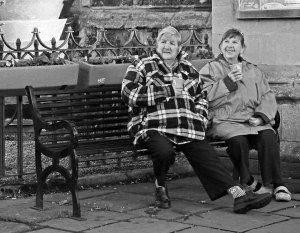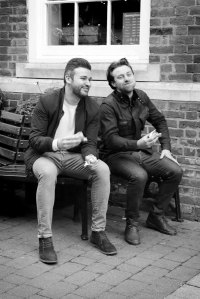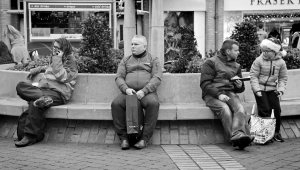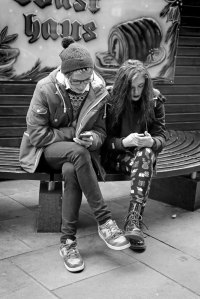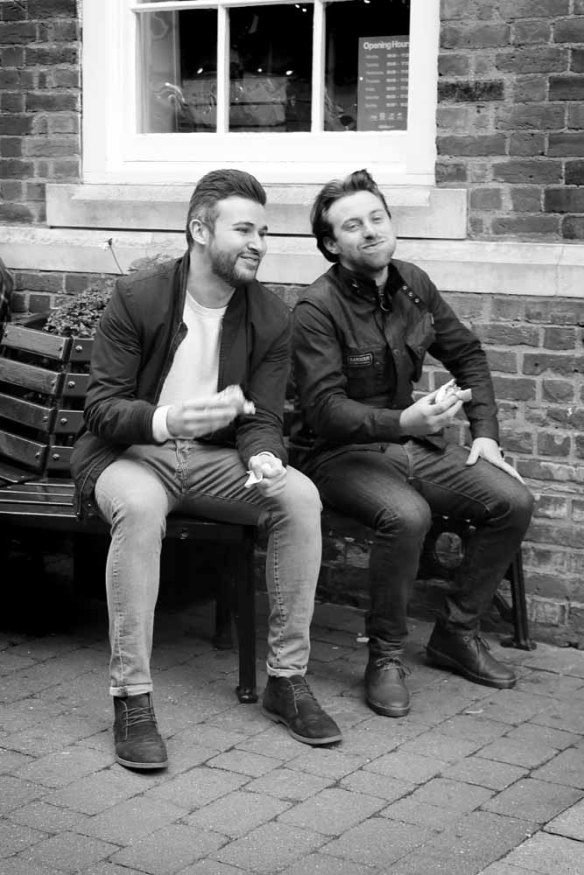After receiving my tutor’s feedback on this assignment, I took another look at the photographs I submitted and made some changes based on this.
The first three shots were of Gainsborough’s House, the childhood home of the artist Thomas Gainsborough, which is now a museum.
My tutor commented that whilst two of the images provided a good idea of the ‘home as a museum’, he could not tell how I was trying to visualise the function of the room in the first shot I took. I chose this picture originally because I liked the composition and the balance of light and dark in the room. I felt it showed reasonably well what the room may have looked like when the artist was resident and therefore created a contrast with the second photograph which shows the house more clearly in its capacity as a museum. Although I agree in some ways with my tutor I have decided to leave this image in the set as it contrasts well with the room shown in the second photograph.

Gainsborough’s House
1/30 F4 ISO 800 @24mm
This photograph has not been altered or changed.
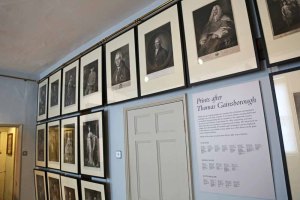
Gainsborough’s House
1/30 F4 ISO 1000 @24mm
This photograph has not been altered or changed though comments were made, using this image as an example, in my feedback that often my analysis of an image is more descriptive than analytical so this is something I need to work on.

Gainsborough’s House
1/30 F4 ISO 640 @24mm
The next building I studied was St Peter’s church and whilst my tutor thought that the first shot showed clearly how the old building was being used he was not so sure the other two photographs were good choices.
This photograph has not been altered or changed.

St Peter’s Church
1/30 F4 ISO 200 @28mm
My tutor commented that he was not sure what I was trying to show with the photograph of the carved screens and I feel that perhaps I could have explained this better in my initial analysis. By photographing the intricate carvings and the stained-glass windows seen in the background, I was trying to show the wealth that the parish must have had in order to have been able to afford such an opulent church. Whilst it does not show anything of the current use of the church, it does give an insight into its past as a busy, spiritual hub in the town and shows some of the intricate architecture off. As my tutor did not feel this added anything to the set of photographs I decided to remove it from the assignment.
I chose to replace it with a photograph taken of the outside of the church as it sits proudly in the centre of the town. I feel that the people and billboards outside, and the statue of Thomas Gainsborough leaning into the frame from the right, help to show that it is a busy and important part of the town.
Omitted

St Peter’s Church
1/60 F4 ISO 3200 @73mm
Replacement

St Peter’s Church
1/640 F18 ISO 100 @24mm
The final photograph I submitted of St Peter’s was my favourite of the assignment, despite its darkness. My tutor commented that it was “too dark to see anything except the windows and the light on the floor” although this was a deliberate choice by me. Rather than showing off the beautiful architecture of the church, I was trying to portray the feeling of calm and spirituality which lingers in this place of worship. When I took this image, I had also taken some others at different exposures so I have decided to substitute the dark photograph with another, much lighter one. Though I do not like this image as much personally, I do feel that with the cleanly swept floors and beautiful light it still shows the peace I was trying to portray in the original image whilst also showcasing the fantastic interior of the building.
Original

St Peter’s Church
1/100 F5.6 ISO 100 @24mm
Replacement

St Peter’s Church
1/50 F5.6 ISO 3200 @24mm
The third building I photographed was the Quay Theatre which, was originally used as a granary. My tutor had some positive comments to make on the first and fourth images of the set which he felt showed well the way that the old building had been successfully renovated and reinvented for a contemporary use.
He commented that the first image could have been improved if there were some people sat at the tables outside though I feel that the empty tables and umbrellas show the use of the space without the added distraction of people. With this in mind I decided not to change this image.

The Quay Theatre
1/125 F5 ISO 100 @67mm
The second image in this set was of a hall with photographs on the wall and my tutor felt that the shallow depth of field and focal plane gave the viewer very little information. With this image I was trying to show the original brickwork and beams and how they contrasted with the modern frames on the wall filled with show posters and news clippings. In my feedback my tutor states that ‘this image doesn’t work at all’ so although I like the composition of this image I have taken on board my tutor’s comments and decided to remove it from the assignment.
Omitted

The Quay Theatre
1/40 F4 ISO 2500 @45mm
The third image was of a room on the top floor which is currently used as a ‘pop-up’ restaurant on a Friday and Saturday evening. My tutor commented that the room would feel more ‘in use’ if there were diners and on reflection I agree with this. Though the tables and chairs are set out in a fashion that suggests dining, the tables are not set and so the room looks almost abandoned. As I am unable take photographs of the room whilst in use, it is a very small space and it would make the diners feel uncomfortable, I have decided to replace this photograph with an image taken in the first floor bar. The image works better to show the use of the room because there are people and their belongings in it. It has a busy feel to it , but as the patrons of the bar are mostly relaxing with their pints, friends and newspapers, their turned backs make sure the room remains the main focus of the photograph.
Original

The Quay Theatre
1/30 F4 ISO 1000 @24mm
Replacement

The Quay Theatre
1/40 F4 ISO 2500 @32mm
This shot has not been altered or changed.
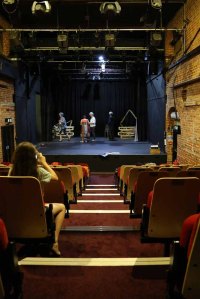
The Quay Theatre
1/30 F4 ISO 5000 @24mm
The next building I photographed was The Mill Hotel which, as the name suggests, is an old flour mill which has been converted into a hotel.
My tutor did not particularly like the first shot as he thought it would have been better composed if taken vertically to show the architecture and to omit the half-sofa to the left of the frame. I re-shot the image to correspond with his advice and although there is a chair and table in the foreground of this shot, which could not be helped unless I rearranged the hotel foyer, it now shows the old beams around the doorway as well as lots more old wooden frames going down the corridor. The new image is also straighter and better shows the contrast between the old floor and beams and the more modern wallpaper.
Original

The Mill Hotel
1/40 F4 ISO 1000 @28mm
Replacement

The Mill Hotel
1/30 F4 ISO 1000 @24mm
My tutor thought the second shot in this set, of the waterwheel, worked well although the exposure was a little compromised to cover the dark and light areas. I agree with this and was initially unsure whether to submit this image because of it. Due to the amount of light coming into the room behind the wheel, which has floor-to-ceiling windows, it is difficult to get a shot which manages to expose both the wheel and the background correctly. It is not helped that the waterwheel itself is encased in watermarked glass, this adds extra glare to the image, particularly where the light behind is brightest.
As I very much like the composition of this image, and my tutor agreed, I have decided to keep it included in this set despite the fact it is not perfectly exposed. I have used a cloning tool to remove some of the window glare near the top of the image and a dodge tool to try and tone down the brightness in the background.
Original

The Mill Hotel
1/60 F4 ISO 800 @80mm
Edited

The Mill Hotel
1/60 F4 IsO 800 @80mm
There was no individual comment about the last photograph in this set but the feedback suggests that my tutor only really liked the waterwheel image. Still, I feel the image is nicely composed and like the way the flowers and pepper shaker are the main focus of the image but they also draw you in to look at the room beyond. Though the depth of field is fairly shallow, the viewer can see enough to know there are several tables and chairs in the room and the items on the table in the foreground, particularly the pepper, suggest the use. Whilst I would have preferred this shot to have been taken with fully set tables and people dining, I was not given permission for this as the hotel felt that the guests would not like it.

The Mill Hotel
1/60 F4 ISO 1000 @60mm
The final building I chose was the old Corn Exchange, which is now a library. My tutor thought this building showed how buildings can be converted for contemporary use well, especially the second shot showing the new mezzanine levels behind the old stone pillars.
He did comment, however, that the cropped image of the exterior did not work particularly well as it needed something more to communicate the conversion better. I had originally framed the exterior of the building very closely as I was trying to show the impressive architecture and not include the modern day road signs and traffic which stand in the way of getting a clear shot of the entire frontage. Upon reflection I can see that the third shot shows part of the original carvings and design so this shot isn’t needed to show similar. With this in mind, I re-shot the image to take in more of the frontage and show how it intermingles with the modern-day town.
Original

Sudbury Library
1/160 F8 ISO 100 @47mm
Replacement

Sudbury Library
1/250 F9 ISO 100 @47mm
This image has not been altered or changed

Sudbury Library
1/50 F5 ISO 100 @24mm
This image has not been altered or changed.

Sudbury Library
1/160 F5 ISO 100 @180mm
As well as the altering of some of my images for this assignment, my tutor mentioned that I need to try to be more analytical and less descriptive in my reflections about each image. From his comments, I think this means that I need to try and explain more fully what I was trying to portray with each image and how well I have achieved that.




